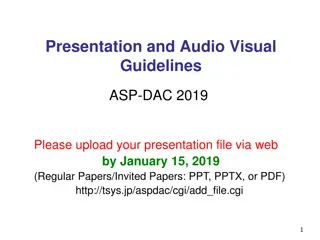Implications of GBF and White Paper on Financial Companies
The Global Biodiversity Framework (GBF) aims to address biodiversity loss and restore ecosystems through urgent action. Financial companies and businesses play a crucial role in the full implementation of the framework by providing adequate financial resources and technology transfer to developing countries. The GBF emphasizes the integration of biodiversity values into policies and development processes to align public and private activities with biodiversity goals.
Download Presentation

Please find below an Image/Link to download the presentation.
The content on the website is provided AS IS for your information and personal use only. It may not be sold, licensed, or shared on other websites without obtaining consent from the author. Download presentation by click this link. If you encounter any issues during the download, it is possible that the publisher has removed the file from their server.
E N D
Presentation Transcript
Implications of the GBF and White Paper on financial companies / business 1
GBF background The CBD COP 15 (Part 2), held in Montreal, Canada, from 7 to 19 December 2022, adopted the Kunming-Montreal Global Biodiversity Framework (GBF) containing a package of measures deemed critical to addressing the loss of biodiversity and restoring natural ecosystems; The GBF aims to catalyze, enable and galvanize urgent and transformative action by Governments to halt and reverse biodiversity loss. Parties are urged to implement the GBF with the full and effective participation and contributions of women, youth, indigenous and local communities, civil society organizations, the private and financial sectors, and stakeholders from all other sectors 2
GBF background Comprises a vision and four goals for 2050, and a mission and 23 action-oriented targets for 2030 The goals and targets of the GBF are global in nature & each Party would contribute to attaining them in accordance with national circumstances, priorities and capabilities The actions set out in each target need to be initiated immediately and completed by 2030. Together, the results will enable achievement towards the outcome- oriented goals for 2050. 3
GBF Implications on financial companies / business The full implementation of the framework will require the provision of adequate, predictable and easily accessible financial resources from all sources on a needs basis It further requires cooperation and collaboration in building the necessary capacity and transfer of technologies to allow developing countries to fully implement the framework. GOAL D Adequate means of implementation, including financial resources, capacity-building, technical and scientific cooperation, and access to and transfer of technology to fully implement the Kunming-Montreal global biodiversity framework are secured and equitably accessible to all Parties, especially developing countries, in particular the least developed countries and small island developing States, as well as countries with economies in transition, progressively closing the biodiversity finance gap of 700 billion dollars per year, and aligning financial flows with the Kunming-Montreal Global Biodiversity Framework and the 2050 Vision for Biodiversity. 4
GBF Implications on financial companies / business TARGET 14 Ensure the full integration of biodiversity and its multiple values into policies, regulations, planning and development processes, poverty eradication strategies, strategic environmental assessments, environmental impact assessments and, as appropriate, national accounting, within and across all levels of government and across all sectors, in particular those with significant impacts on biodiversity, progressively aligning all relevant public and private activities, fiscal and financial flows with the goals and targets of this framework. 5
GBF Implications on financial companies / business TARGET 15 Take legal, administrative or policy measures to encourage and enable business, and in particular to ensure that large and transnational companies and financial institutions: (a) Regularly monitor, assess, and transparently disclose their risks, dependencies and impacts on biodiversity, including with requirements for all large as well as transnational companies and financial institutions along their operations, supply and value chains and portfolios; (b) Provide information needed to consumers to promote sustainable consumption patterns; (c) Report on compliance with access and benefit-sharing regulations and measures, as applicable; in order to progressively reduce negative impacts on biodiversity, increase positive impacts, reduce biodiversity-related risks to business and financial institutions, and promote actions to ensure sustainable patterns of production 6
GBF Implications on financial companies / business TARGET 19 Substantially and progressively increase the level of financial resources from all sources, in an effective, timely and easily accessible manner, including domestic, international, public and private resources, in accordance with Article 20 of the Convention, to implement national biodiversity strategies and action plans, by 2030 mobilizing at least 200 billion United States dollars per year, including by: (a) Increasing total biodiversity related international financial resources from developed countries, including official development assistance, and from countries that voluntarily assume obligations of developed country Parties, to developing countries, in particular the least developed countries and small island developing States, as well as countries with economies in transition, to at least US$ 20 billion per year by 2025, and to at least US$ 30 billion per year by 2030; (b) Significantly increasing domestic resource mobilization, facilitated by the preparation and implementation of national biodiversity finance plans or similar instruments according to national needs, priorities and circumstances; (c) Leveraging private finance, promoting blended finance, implementing strategies for raising new and additional resources, and encouraging the private sector to invest in biodiversity, including through impact funds and other instruments; (d) Stimulating innovative schemes such as payment for ecosystem services, green bonds, biodiversity offsets and credits, and benefit-sharing mechanisms, with environmental and social safeguards; (e) Optimizing co-benefits and synergies of finance targeting the biodiversity and climate crises; (f) Enhancing the role of collective actions, including by indigenous peoples and local communities, Mother Earth centric actions and non-market-based approaches including community based natural resource management and civil society cooperation and solidarity aimed at the conservation of biodiversity; (g) Enhancing the effectiveness, efficiency and transparency of resource provision and use; 7
White Paper background Approved by Cabinet in March 2023 for implementation following an extensive consultation process Comprises vision, four goals, two cross-cutting enablers, 32 policy objectives as follows: 8 for Goal 1 5 for Goal 2 2 for Goal 3 7 for Goal 4 4 for Enabler 1 6 for Enabler 2 Each of the policy objectives has associated outputs and outcomes 8
White Paper implications GOAL 1: ENHANCED BIODIVERSITY CONSERVATION: All biological diversity and its components conserved Expected outcome:: 1. Expanded, connected, thriving, representative, inclusive, and effectively managed protected and conservation areas, including coordinated partnerships. 2. Species of special concern, including their genetic diversity, conserved, and viable populations maintained. 3. Contributions to global biodiversity conservation targets. Expected output: Policy objective: 5. Effective participation of landowners, business, traditional leaders, local communities and other interested and affected parties in expansion, management and custodianship of protected and conservation areas. 1.1. Expand a representative system of protected and conservation areas that are effectively and efficiently managed.. 9
ENABLER 2: ENHANCED MEANS OF IMPLEMENTATION: Expanded and developed ability to effectively conserve biodiversity, to manage its use and benefits, whilst addressing factors threatening biodiversity Policy objective: E2.6. Mobilise resources from all sources, including identification of innovative financial mechanisms, to promote financial sustainability of the sector. Expected Output 1. Provision of financial support and incentives, within available financial resources, in respect of activities which are intended to achieve the goals, objectives, and outcomes of the White Paper. 2. Enhanced financial sustainability of state biodiversity conservation, including for sustaining and expanding state protected areas. 3. Integrated and innovative mechanisms, funding and investment models, and resource mobilisation, including internationally, to support biodiversity conservation and sustainable use. 4. Mechanisms and tools, developed in partnership with the private sector, to facilitate access to capital, and financial training and support, for new entrants to the biodiversity sector. 5. Fiscal instruments in place that promote and incentivise biodiversity conservation and growing the biodiversity economy. 6. Innovative approaches, with mechanisms for reinvestment, change business practices to reduce biodiversity loss, adding net value, or at least ensure no net biodiversity loss. 7. Market instruments, such as certification schemes, enhance reputation and market share of high-standard sustainable use products and practices. 8. External financing sources pursued through bilateral and multilateral agencies, and the private sector, to secure funding for priority programmes and projects. 9. Biodiversity offsets enhance affected biodiversity, or at least ensure no net biodiversity loss. 10. Regulatory certainty created for implementation of innovative biodiversity offsetting instruments, such as strategic biodiversity offsets and biodiversity offset banking. Expected outcome: Financial incentives are harnessed and leveraged from all sources to ensure the biodiversity sector is adequately resourced, and transformed. support and 10
THANK YOU! 11























